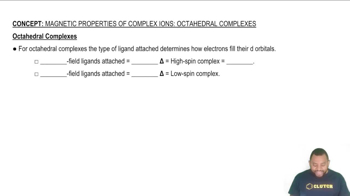Ch.23 - Transition Metals and Coordination Chemistry
Chapter 23, Problem 42
Complete the exercises below. Consider an octahedral complex MA₃B₃. How many geometric isomers are expected for this compound? Will any of the isomers be optically active? If so, which ones?
 Verified step by step guidance
Verified step by step guidance1
Step 1: Understand the structure of an octahedral complex. An octahedral complex has six ligands symmetrically arranged around a central metal atom. In the complex MA₃B₃, there are two types of ligands: three A ligands and three B ligands.
Step 2: Identify possible geometric isomers. In an octahedral complex like MA₃B₃, the ligands can be arranged in different ways. The two primary arrangements are facial (fac) and meridional (mer). In the fac isomer, the three identical ligands (A or B) occupy one face of the octahedron, while in the mer isomer, they are arranged in a plane that includes the central metal atom.
Step 3: Determine the number of geometric isomers. For the MA₃B₃ complex, there are two geometric isomers: fac-MA₃B₃ and mer-MA₃B₃.
Step 4: Assess optical activity. Optical activity in a complex arises when the complex is chiral, meaning it has a non-superimposable mirror image. In the case of MA₃B₃, the fac isomer can be chiral if it lacks a plane of symmetry, potentially making it optically active.
Step 5: Conclude which isomers are optically active. The fac isomer of MA₃B₃ can be optically active if it is chiral, while the mer isomer is typically not optically active due to its symmetry.
Key Concepts
Here are the essential concepts you must grasp in order to answer the question correctly.
Octahedral Complexes
An octahedral complex is a type of coordination compound where a central metal atom is surrounded by six ligands arranged at the corners of an octahedron. The geometry of these complexes can lead to different spatial arrangements of the ligands, which is crucial for determining the number of geometric isomers.
Recommended video:
Guided course

For octahedral complexes, Weak-Field Ligands create High-spin complexes and Strong-Field Ligands create Low-spin complexes.
Geometric Isomerism
Geometric isomerism occurs when compounds have the same molecular formula but differ in the spatial arrangement of their atoms. In octahedral complexes like MA₃B₃, the arrangement of the three identical ligands (A) and three different ligands (B) can lead to distinct isomers, such as facial (fac) and meridional (mer) isomers.
Recommended video:
Guided course

Geometric Isomers
Optical Activity
Optical activity refers to the ability of a compound to rotate plane-polarized light, which occurs in chiral molecules that lack an internal plane of symmetry. In the context of the isomers of MA₃B₃, only those that are non-superimposable on their mirror images will exhibit optical activity, which can be determined by analyzing their spatial arrangements.
Recommended video:
Guided course

Activity Series Chart
Related Practice
